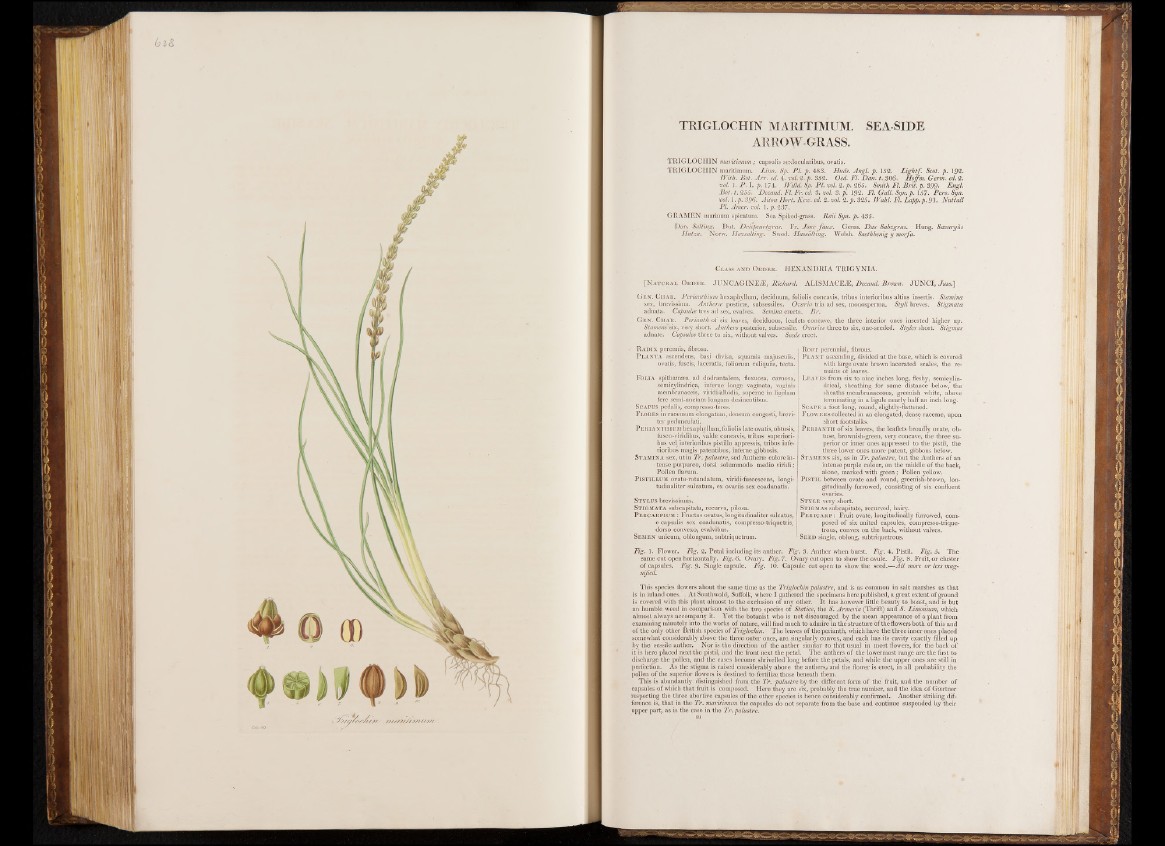
7/t
TRIGLOCHIN maritimum; capsulis sexlocularibus, ovatis.
TRIGLOCHIN maritimum. Linn, Sp. PI. p . 483. Huds. Angl, p . Ï52. Lightf. Scot. p . 192.
With. Bot. Arr. cd. 4. vol. 2. p. 352. Oed. Fl. Dan. t..806. Hoffm. Germ. ed. 2.
vol. l. P . I. p. 174. Willd. Sp. PI. vol. 2. p . 265. Smith Fl. B r it.p . 399- Engl.
Bot. t. 255. Dccand. Fl. Fr. cd. 3. vol. 3. p. 192. Fl. Gall. Syn. p. 157. Pers. Syn.
vol. l.p . 396. Aiton Hort. Kexo'. ed. 2. vol. 2 .p . 325. Wahl. Fl. Lapp.p. 91.- Nuttall
PI. Amer. vol. l.p . 237; :
GRAMEN marinum spicatum. Sea Spiked-grass. Raii Syn. p . 435.
Dan. Salting. Dut. Di'iepeurtgras. Fr. Jonc fau x. Germ. Das Sabzgras. Hung. Savaryus
Ilutza. Norw. Havsalting. Swed. Hassa/ting. Welsh. Saethbenig y morfa.
[N atural Ord e r . JUNCAGINEÆ, Richard. ALISMACEÆ, Dccand. Br
G e n . Ch a r. Periantkium hexaphyllum, deciduum, folioiis concavis.
ses, brevissima. Antheroe posticæ, subsessiles. Ovaria tria ad s
adnata. Capsulæ très ad sex, evalves. Semina erecta. Br.
G e n . Ch a r . Perianth of six leaves, deciduous, leaflets concave, the three interior ones inserted higher up.
Slamens’"s\x, very short. Anthers posterior,.subsessile. Ovaries three to six, one-seeded. Styles short. Stigm
adnate. Capsules three to six, without valves. Seeds erect.
R adix perennis, fibrosa.
P lanta asçendens, basj divisa, squamis majusculis,
ovatis, fuscis, laceratis, foliorum reliquiis, tecta.
Folia spithamæa ad dodrantalem, flexuosa, carnosa,
semicylindrica, inferne' longe vaginata, vaginis
membranaceis, viridi-'albidis, superne in ligulam
fere semi-unciam longam desinentibus.
Scapus pedalis, compresso-teres.
Flores in racemum elongatum, densum congesti, brevi-
ter pedunculati.
P e r ia n t iiium hexaphyllum,folioiis late ovatis, obtusis,
fusco-viridibus, valde concavis, tribus superiori-
bus vel interioribus pistillo appressis, tribus i'nfe-
rioribus magis patentibus, inferne gibbosis.
Stamin a sex, utin Tr. palustre, sed Antheræ colore in-
• tense purpureo, dorsi solummodo medio vifidi ;
Pollen flavum.
P istillum ovato-rotundatum, viridi-fuscescens, longi-
tudinaliter sulcatum, ex ovariis sex coaduhatis.
Stylus brevissimus.
Stigmata subcapitata, recurva, pilosa.
P ercarpium : Fructus ovatus, longitudinalitersùlcatus,
e capsulis sex coadunatis, compresso-triquetris,
dorso convexo, evalvibus.
Semen unicum, oblongum, subtriquetrum.
| Root perennial, fibrous.
P lant ascending, divided a t the base, which is
with large ovate brown lacerated scales, the remains.
of [eaves.
L eaves from six to nine inches long, fleshy, semicylin-
drical, sheathing for some distance below, the
sheaths membranaceous, greenish white, above
terminating in a ligule nearly h alf an inch long.
Scape a foot long, round, slightly-flattened.
F lowers collected in an elongated, dense raceme, upon
short footstalks.
P e r ia n t h of six leaves, the leaflets broadly ovate, obtuse,
brownish-green, very concave, the three superior
or inner ones appressed to the pistil, the
three lower ones more patent, gibbous below.
ENS six, as in Tr. palustre, but the Anthers of an
intense purple colour, on the middle of the back,
alone, marked with green; Pollen yellow.
I Pis t il between ovate and round, greenish-brown, longitudinally
furrowed, consisting o f six confluent
ovaries.
Style very short.
Stigmas subcapitate, recurved, hairy.
P e r ic a r p : Fruit ovate, longitudinally furrowed, composed
of six united capsules, compresso-trique-
trous, convex on the back, without valves.
Se ed single, oblong, subtriquetrous.
Fig. 1. Flower. Fig. 2. Petal including its anther. Fig. 3. Anther when burst. Fig. 4. Pistil. Fig. 5. The
cut open horizontally. Fig. 6. Ovary. Fig. 7. Ovary cut open to show the ovule. Fig. 8. Fruit, or cluster
of capsules. Fig. 9. Single capsule. Fig. 10. Capsule cut open to show.the seed.—A ll more or less magnified.
This species flowers about the same time as the Triglochin palustre, and is as common in salt marshes as that
in inland ones. . At Sou thwold, Suffolk, where I gathered- the specimens here published, a great extent of ground
•ith this plant almost to the exclusion of any other. It has however little beauty to. boast, and is but
an humble weed in comparison with the two species of Statice, the S. Armeria (Thrift) and S. Limonium, which
almost always accompany it. Yet the botanist who is not discouraged by the mean appearance of a plant from
examining minutely into the works of nature, will find much to admire in the structure of the flowers both of this and
of the only other British species of Triglochin. The leaves of the perianth, which have the three inner ones placed
somewhat considerably above the three outer ones, are singularly convex, and each has its cavity exactly filled up
by the sessile anther. Nor is the direction of the anther similar to that usual in most flowers, for the back of
it is here placed next the pistil, and the front next the petal. The anthers of the lowermost range are the first to
discharge the pollen, and the cases become shrivelled long before the petals, and while the-upper ones are still in
perfection. As the stigma is raised considerably above the anthers* and the flower is erect, in all probability the
pollen of the superior flowers is destined to fertilize, those beneath them.
This is abundantly distinguished from the Tr. palustre by the different form of the fruit, and the number of
capsules of which that fruit is composed. ‘Here they are six, probably the true number, and the idea of Gasrtner
respecting the three abortive capsules of the other species is hence considerably confirmed. Another striking difference
is, that in the Tr. maritimum the capsilles do not separate from the base and continue suspended by their
upper part, as is the case in the Tr. palustre.